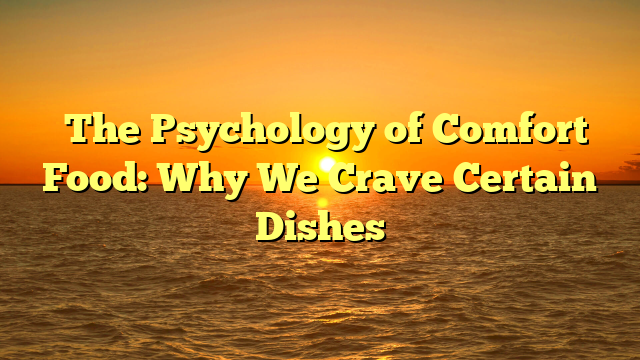
Everyone has a go-to comfort food—whether it’s a bowl of mac and cheese, a slice of warm apple pie, or a steaming bowl of ramen. But have you ever wondered why these foods bring us such deep satisfaction?
Comfort food is more than just a meal; it’s a psychological and emotional experience. It can bring back memories, provide a sense of security, or even boost our mood. In this article, we’ll explore the science behind comfort food, why we crave it, and how it affects our emotions and brain chemistry.
1. What Is Comfort Food?
Comfort food is defined as any food that provides a sense of nostalgia, emotional relief, or psychological comfort. These foods vary based on culture, personal experience, and upbringing.
🍲 Examples of comfort foods worldwide:
✅ USA – Mac and cheese, fried chicken, chocolate chip cookies.
✅ Japan – Ramen, miso soup, onigiri (rice balls).
✅ India – Biryani, dal (lentil stew), chai tea.
✅ France – Baguette with butter, croissants, ratatouille.
✅ Mexico – Tacos, tamales, churros.
The foods we find comforting are often linked to childhood, home, or specific life experiences.
2. The Science Behind Comfort Food Cravings
Why do we crave specific foods when we’re sad, stressed, or nostalgic? The answer lies in brain chemistry and psychology.
🧠 Dopamine & Serotonin Boosters
Many comfort foods are rich in carbohydrates, fats, and sugar, which trigger the release of dopamine and serotonin—the “feel-good” neurotransmitters. This makes us feel happy and relaxed.
👶 Childhood Associations
Many of our comfort foods are linked to early memories. If your parents gave you soup when you were sick as a child, you might crave soup as an adult when you’re feeling unwell.
💡 Cultural & Emotional Connections
Comfort food is also tied to cultural identity. Dishes that remind us of home, family, or a special time in our lives often become sources of comfort.
3. When Do We Seek Comfort Food?
Research shows that people turn to comfort food in specific situations:
🥶 Cold weather – Warm, hearty meals like soups and stews become more appealing.
💔 Emotional distress – Breakups or stress often trigger cravings for ice cream or chocolate.
📺 Nostalgic moments – Watching old movies or visiting childhood places makes us crave familiar flavors.
🎉 Celebrations – Holidays and birthdays often feature indulgent comfort foods.
4. The Role of Gender in Comfort Food Choices
Studies suggest that men and women crave different types of comfort foods:
👨 Men tend to prefer protein-heavy or meal-like comfort foods, such as steak, pizza, or pasta.
👩 Women are more likely to crave sweet and snack-like comfort foods, such as chocolate or cookies.
However, powerlensnews.5g.in and cultural influences play a big role in what we consider comforting.
5. The Dark Side of Comfort Food: Emotional Eating
While comfort food can boost mood and relieve stress, excessive reliance on it can lead to:
⚠️ Emotional eating – Using food as the primary way to cope with stress or sadness.
⚠️ Overeating & weight gain – Many comfort foods are high in calories, sugar, and fat.
⚠️ Guilt & unhealthy habits – Feeling guilty after eating comfort foods can create a negative cycle.
To avoid unhealthy emotional eating, balance is key.
6. How to Enjoy Comfort Food in a Healthy Way
You don’t have to give up your favorite comfort foods! Here’s how to enjoy them mindfully:
🥗 Healthier versions – Swap ingredients (e.g., using whole-grain pasta for mac and cheese).
🍽️ Portion control – Enjoy comfort food in moderation.
🧘 Find alternative coping mechanisms – Exercise, music, or talking to a friend can also relieve stress.
7. Conclusion: The Power of Comfort Food
Comfort food is more than just fuel for the body—it’s a source of emotional connection, nostalgia, and happiness. While it can lift our spirits, it’s important to enjoy it mindfully and not rely on it as the only coping mechanism for stress.
So, the next time you indulge in your favorite comfort food, take a moment to appreciate not just the taste, but the memories and emotions that come with it. 🍕❤️




